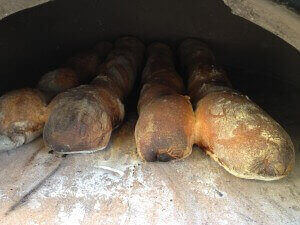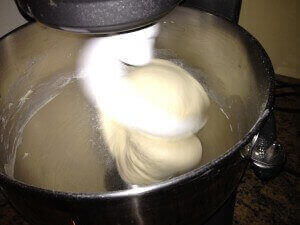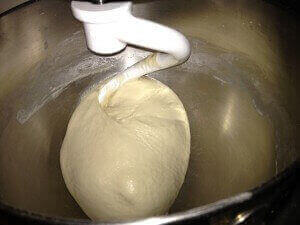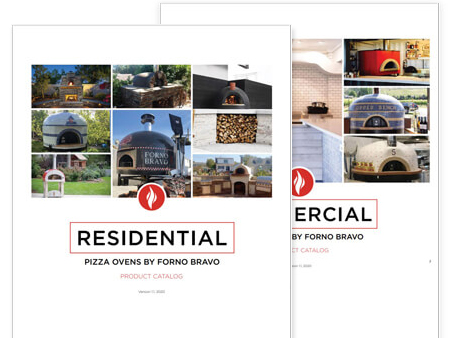Technique and a Really Good Baguette
May 26, 2012Posted by Forno BravoIn my quest to learn to make a better baguette (dare I say a good baguette?), I have been experimenting with new techniques, reading about the science, watching videos, tuning my equipment (pizza oven, etc.) and even making equipment (my baguette flipper). I have been deconstructing the process and learning how to make beyond my initial attempts, which I would characterize as follows:
1. Mix 80% room temperature water dough for 8 minutes at low speed.
2. Bulk ferment for an hour or so.
3. Shape baguettes and let them proof on the counter.
4. Transfer them into the pizza oven by hand using the back of a baking sheet.
I would say that my results have been OK, but I want more. My flavor is good, the crumb texture is OK, the crust is only so-so, and my slashing is downright awful. In my defense, my baguettes are still better than just about anything we can buy locally.
So I want more.
Plus, I have always enjoyed learning new skills—it’s what keeps a middle-aged guy going, and I think that being self-taught is the way to go.
My initial steps toward improvement were primarily at the back-end of the process. Improved baguette shaping and a better method for loading my loaves into the oven. And that has been helping. But until I improve the quality of my dough, the back-end improvements will only get me so far. GIGO. Well, not that extreme. MEMO. Mediocre In…
Today’s work is focused on the dough.
To start, I have been reading more about gluten development and working with high hydration dough. There seem to be a number of elements of dough preparation that I can easily improve, without significantly increasing the complexity or time commitment of my daily baking. In no particular order:
1. Temperature control.
I am starting to work with ice-water and overnight fermentation, rather than a short fermentation at room temperature. In today’s batch I mixed an 80% hydration dough using ice water and an overnight fermentation in the refrigerator.
2. Higher speed mixing for better gluten developement.
Wet doughs require more mixing in order to develop the gluten your bread needs for a nicely structured crumb. In my previous ice water baguette batch, I mixed the dough for about 8 minutes on a low setting at the end of the evening. It was basically undeveloped, but it was late, so I put it in the refrigerator, hoping the overnight fermentation would improve the structure. It didn’t. And the resulting baguettes were very flat and did not have very much (if any) oven spring. In this batch, I mixed the dough faster (the 4th speed) and longer—a little more than 10 minutes. I could definitely see the gluten developing and the strand in the dough becoming elongated. Over the mixing time, the dough went from batter, to a sticky mess, and actually forming a dough ball.
3. Folding during bulk fermentation for better dough strength.
This is another good way of helping the dough develop a strong gluten structure, without over-mixing your dough during the initial kneading. There has been a lot written recently on no-knead dough (very high hydration, un-kneaded dough left to ferment for long periods of time) and folded doughs (where lots of folding takes the place of a higher speed initial knead), and there seems to be a consensus that folding after bulk fermentation helps build gluten structure without overworking the dough to where oxygen depletes the flour.
I found a great YouTube video that demonstration high hydration dough folding. I really like the instructor’s methodical approach, and I have started incorporating this into my bread making technique. Working with very wet dough is incredibly important if you want to make the traditional light, crusty European breads, including Baguettes, ciabatta and Pugliese.
httpvh://www.youtube.com/watch?v=C-0FEBOkUR4
Now, if I can learn to combine my improved “front-end” techniques with the “back-end” techniques that I have been trying to master, I might get somewhere.








